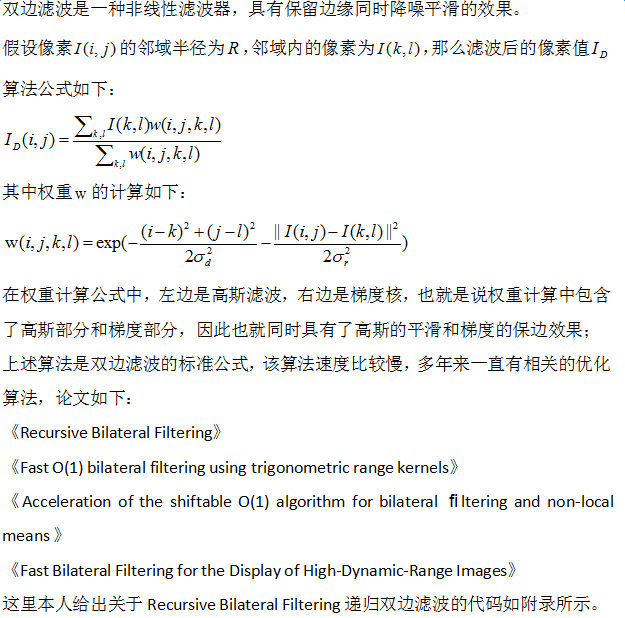双边滤波算法
#include "string.h"
#include "stdio.h"
#include "stdlib.h"
#include "math.h"
#include"SoftSkin.h"
//垂直方向递归
void runVerticalHorizontal(double *data,int width,int height,double spatialDecay,double *exp_table,double *g_table)
{
int length0=height*width;
double* g= new double[length0];
int m = 0;
for (int k2 = 0;k2<height;++k2)
{
int n = k2;
for (int k1 = 0;k1<width;++k1)
{
g[n]=data[m++];
n += height;
}
}
double*p = new double[length0];
double*r = new double[length0];
memcpy(p, g, sizeof(double) * length0);
memcpy(r, g, sizeof(double) * length0);
for (int k1 = 0;k1<width; ++k1)
{
int startIndex=k1 * height;
double mu = 0.0;
for (int k=startIndex+1,K =startIndex+height;k<K;++k)
{
int div0=fabs(p[k]-p[k-1]);
mu =exp_table[div0];
p[k] = p[k - 1] * mu + p[k] * (1.0 - mu);//文献中的公式1,这里做了一下修改,效果影响不大
}
for (int k =startIndex+height-2;startIndex <= k;--k)
{
int div0=fabs(r[k]-r[k+1]);
mu =exp_table[div0];
r[k] = r[k+1] * mu + r[k] * (1.0-mu) ;//文献公式3
}
}
double rho0=1.0/(2-spatialDecay);
for (int k = 0;k <length0;++k)
{
r[k]= (r[k]+p[k])*rho0-g_table[(int)g[k]];
}
m = 0;
for (int k1=0;k1<width;++k1)
{
int n = k1;
for (int k2 =0;k2<height;++k2)
{
data[n] = r[m++];
n += width;
}
}
memcpy(p,data, sizeof(double) * length0);
memcpy(r,data, sizeof(double) * length0);
for (int k2 = 0; k2<height;++k2)
{
int startIndex=k2 * width;
double mu = 0.0;
for (int k=startIndex+1, K=startIndex+width;k<K;++k)
{
int div0=fabs(p[k]-p[k-1]);
mu =exp_table[div0];
p[k] = p[k - 1] * mu + p[k] * (1.0 - mu);
}
for (int k=startIndex+width-2;startIndex<=k;--k)
{
int div0=fabs(r[k]-r[k+1]);
mu =exp_table[div0];
r[k] = r[k + 1] * mu + r[k] * (1.0 - mu) ;
}
}
double init_gain_mu=spatialDecay/(2-spatialDecay);
for (int k = 0; k <length0; k++)
{
data[k]=(p[k]+r[k])*rho0-data[k]*init_gain_mu;//文献中的公式5
}
delete p;
delete r;
delete g;
}
//水平方向递归
void runHorizontalVertical(double *data,int width,int height,double spatialDecay,double *exptable,double *g_table)
{
int length=width*height;
double* g = new double[length];
double* p = new double[length];
double* r = new double[length];
memcpy(p,data, sizeof(double) * length);
memcpy(r,data, sizeof(double) * length);
double rho0=1.0/(2-spatialDecay);
for (int k2 = 0;k2 < height;++k2)
{
int startIndex=k2 * width;
for (int k=startIndex+1,K=startIndex+width;k<K;++k)
{
int div0=fabs(p[k]-p[k-1]);
double mu =exptable[div0];
p[k] = p[k - 1] * mu + p[k] * (1.0 - mu);//文献公式1
}
for (int k =startIndex + width - 2;startIndex <= k;--k)
{
int div0=fabs(r[k]-r[k+1]);
double mu =exptable[div0];
r[k] = r[k + 1] * mu + r[k] * (1.0 - mu);//文献公式3
}
for (int k =startIndex,K=startIndex+width;k<K;k++)
{
r[k]=(r[k]+p[k])*rho0- g_table[(int)data[k]];
}
}
int m = 0;
for (int k2=0;k2<height;k2++)
{
int n = k2;
for (int k1=0;k1<width;k1++)
{
g[n] = r[m++];
n += height;
}
}
memcpy(p, g, sizeof(double) * height * width);
memcpy(r, g, sizeof(double) * height * width);
for (int k1=0;k1<width;++k1)
{
int startIndex=k1 * height;
double mu = 0.0;
for (int k =startIndex+1,K =startIndex+height;k<K;++k)
{
int div0=fabs(p[k]-p[k-1]);
mu =exptable[div0];
p[k] = p[k - 1] * mu + p[k] * (1.0 - mu);
}
for (int k=startIndex+height-2;startIndex<=k;--k)
{
int div0=fabs(r[k]-r[k+1]);
mu =exptable[div0];
r[k] = r[k + 1] * mu + r[k] * (1.0 - mu);
}
}
double init_gain_mu=spatialDecay/(2-spatialDecay);
for (int k = 0;k <length;++k)
{
r[k]= (r[k]+p[k])*rho0- g[k]*init_gain_mu;
}
m = 0;
for (int k1=0;k1<width;++k1)
{
int n = k1;
for (int k2=0;k2<height;++k2)
{
data[n]=r[m++];
n += width;
}
}
delete p;
delete r;
delete g;
}
void ApplyBiExponentialEdgePreservingSmoother(double photometricStandardDeviation, double spatialDecay, unsigned char* m_pImage, int m_nWidth, int m_nHeight,int m_nStride)
{
double m_exp_table[256];
double m_g_table[256];
memset(m_exp_table, 0, 256);
memset(m_g_table, 0, 256);
double c=-0.5/(photometricStandardDeviation * photometricStandardDeviation);
double mu=spatialDecay/(2-spatialDecay);
for (int i=0;i<=255;i++)
{
float a=exp(c*i*i);
m_exp_table[i]=(1-spatialDecay)* exp(c*i*i);
m_g_table[i]=mu*i;
}
unsigned char* p0 =m_pImage;
const int nChannel = 4;
int m_length =m_nWidth*m_nHeight;
float maxerror=0;
float sum=0;
// 对每个channel进行处理
for (int idxChannel=0;idxChannel <nChannel; idxChannel++)
{
double *data1 = new double[m_length];
double* data2 = new double[m_length];
unsigned char *p1=p0+idxChannel;
for (int i = 0; i < m_length;++i)
{
data1[i] = p1[i * nChannel];
}
memcpy(data2,data1, sizeof(double) * m_length);
runHorizontalVertical(data1, m_nWidth, m_nHeight,spatialDecay,m_exp_table,m_g_table);
runVerticalHorizontal(data2, m_nWidth, m_nHeight,spatialDecay,m_exp_table,m_g_table);
sum=0;
for (int i =0;i<m_length;++i)
{
double val=(data1[i] + data2[i]) * 0.5;
if(255.0<val)val=255.0;
p1[i * nChannel]=(unsigned char)val;
}
delete data1;
delete data2;
}
}
void f_Bilateralfilter(unsigned char* pImage, int nWidth, int nHeight, int nStride, double std)
{
if (pImage == NULL || std == 0)
{
return;
}
ApplyBiExponentialEdgePreservingSmoother(std,std * 0.001,pImage, nWidth, nHeight, nStride);
}
效果如下:
原图
双边滤波效果图(Delta=20)
递归双边滤波是一种快速双边滤波算法,这里本人是对四通道处理的,大家可以在YUV颜色空间对Y通道处理,UV不变,这样速度会更快一些。
完整的DEMO连接:点击打开链接


